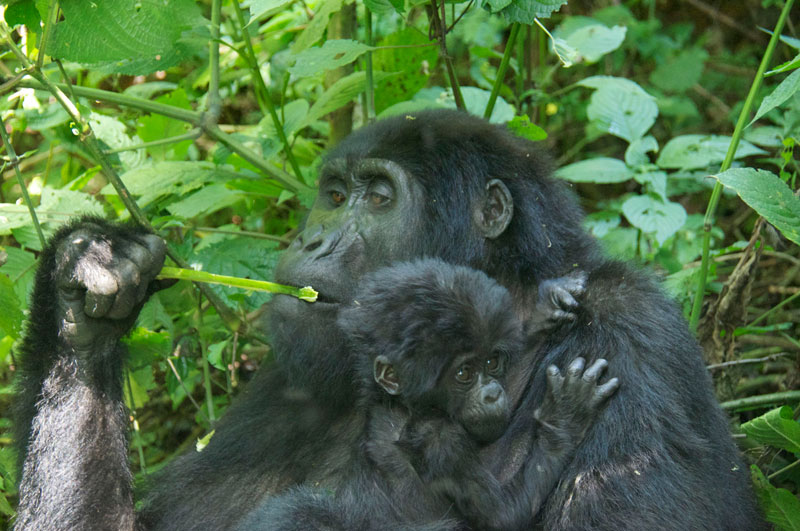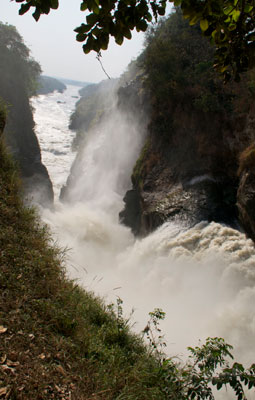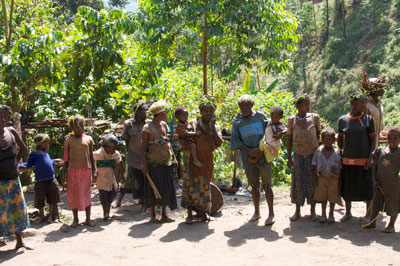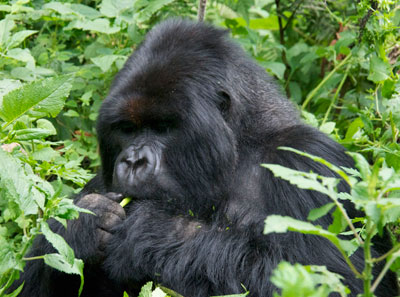A tale of two treks – visiting the mountain gorillas of Uganda and Rwanda
This article appears on page 30 of the January 2016 issue.
Paging through travel brochures in search of my next adventure, I discovered various gorilla treks, and the idea that you could actually get close to them and watch them in their natural habitat piqued my interest. But how do you choose where to see these African mountain gorillas: Uganda or Rwanda?
Luckily, I didn’t have to choose one over the other because I found a trip that went to both countries. I would be able to compare the treks and would be lucky enough to have two chances to see gorillas in the wild!
Making plans
My husband, Richard, and I signed up for an 18-day trip limited to 16 people offered by ElderTreks (Toronto, Ont., Canada; 800/741-7956, www.eldertreks.com). Priced at $7,645 per person, double occupancy (not including airfare), this trip was scheduled for Jan. 15-Feb. 2, 2015, during the dry season and when temperatures would be between 60° and 80°F. All meals, accommodations, excursions, bottled water, tips to the hotel porters and drivers, the assistance of one porter per person for each gorilla trek, and all airport transfers (even if you arranged your own flights) were included.
Not only was a trip deposit required up front, but the nonrefundable park-entry permits (for viewing both chimpanzees and gorillas) had to be purchased immediately, as a limited number are issued. The prices per person for the permits were $150 for the chimpanzee visit, $500 for the Uganda park and $750 for Rwanda.
Months before the trip, we went to a travel clinic to understand what vaccinations were needed. We learned that proof of yellow fever immunization and malaria medication would be required. Typhoid fever, flu and hepatitis B vaccinations were recommended. The nurse also advised us to purchase insect repellant that was 30%-35% DEET and to pack antibiotics.
Richard and I arranged our own flights to Entebbe, Uganda, arriving one day before our tour in order to combat jet lag and insure we did not miss the scheduled welcome dinner. (Flights from Europe arrive late in the evening.)
Upon arriving in Entebbe, we were required to purchase Uganda visas, which cost $100 per person, payable in US currency in bills dated 2006 or later.
Since airport transfers were included, we were met outside of the airport by our guide, Ham Juuko, and were taken to the Boma Hotel for a 3-night stay. Our extra night at the hotel cost $180.
The Boma Hotel was 10 minutes from the airport and within walking distance of the town of Entebbe. Once a colonial homestead, the Boma was converted into a hotel set in a tropical garden.
Joining the group
Our first group excursion was to the Entebbe Botanical Gardens, where we saw African grey parrots and flying foxes in the trees. There was also an area where, we were told, scenes from the Tarzan movies with Johnny Weissmuller were filmed. You can see the hanging vines among the trees and imagine Tarzan and Jane swinging through the jungle.
In the afternoon, we took a boat to the Ngamba Island Chimpanzee Sanctuary in Lake Victoria. We enjoyed lunch there, then went to a platform to watch the chimpanzees as they came out of the forested area for a feeding.
After an overnight in the capital city of Kampala, it was a long drive to Murchison Falls National Park, with only “bush stops” for bathroom breaks. That meant finding a secluded area and making sure you brought Kleenex, hand sanitizer and small Ziploc bags for the trash.
Roads were paved near the cities, but everywhere else had bumpy dirt roads. Our jeep’s windows had to be closed due to the dust and tsetse flies, and the air-conditioning didn’t always work. I’d recommend taking along a small battery-operated fan to stay cool.
Before reaching the falls, we stopped at the Ziwa Rhino Sanctuary. Rhinos were wiped out in Uganda by 1983, making this the only place in the country to see white rhinos in the wild.
The rhino reintroduction project started with six white rhinos; presently, there are 15 in the sanctuary.
During a walking safari, we were able to get within 25 to 30 meters of a white rhino nursing a baby.
Murchison Falls is a large waterfall on the White Nile River that explodes from a narrow opening and cascades into Lake Albert. The surrounding area is home to an assortment of wildlife, best seen on a boating safari.
The riverbanks were alive with hippos, crocodiles and elephants. There were bee-eaters and kingfishers whose feathers were the color of molten gems. If you’re lucky, your safari will reveal the massive shoebill stork, which stands nearly four feet tall.
At Murchison Falls we stayed at Baker’s Lodge for three nights. Unfortunately, not all of the cabins at this newly opened lodge were completed, so half of the group stayed in luxurious cabins and the other half were assigned tents. It might sound romantic to stay in a tent, but our tent did not have electricity or a flushing toilet for two of the three days we stayed there.
The cabins were equipped with mosquito netting as well as whistles and sirens for emergencies, but none of these items were available in the tents.
ElderTreks did compensate the “tent people” for our inconvenient experience, and we give them credit for their swift response.
Kibale
From Murchison Falls National Park, it was a full day’s drive to Kibale National Park, traveling through mountains covered by tea plantations for as far as the eye could see.
We continued up the mountains to Ndali Lodge, situated on the rim of Nyinambuga Crater Lake. Our home for two nights had spacious individual bungalows with wonderful views of the surrounding mountains. The grounds included a pool and beautifully landscaped gardens, and the lodge included free laundry service. Dinner was served in the main lodge under chandeliers of blazing candles. It was a very relaxing stay.
At Kibale National Park, we had a rare opportunity to see chimpanzees in the wild. On our first forest trek, we were instructed to either wear gaiters or pull our socks over our pants to prevent fire ants from climbing up our legs.
As we walked through the forest with our guide, we could hear the chimpanzees before we actually saw them. We found them high in the trees looking down at us. Before we knew it, they had climbed down to pose for photos.
We were allowed to stay with the chimpanzees for one hour, and I enjoyed every minute.
Afterward, we were treated to a home-hosted lunch with typical Ugandan dishes: chapati (flatbread), sweet potatoes and beef from Ankole Longhorn cows, plus jackfruit for dessert.
Into the forest
After visits to Queen Elizabeth National Park and nearby Ishasha, where we searched high and low for the famous tree-climbing lions, eventually encountering a few on our way out of the park, our excitement was building because we would soon be arriving at Bwindi Impenetrable Forest for our first gorilla trek!
When we reached Bwindi, we were shown the many community improvements that have come from gorilla-trekking funds. Then we were taken to the well-managed Buhoma Lodge, where we spent three nights.
At our gorilla-trek briefing, we were told to carry a walking stick, two liters of water and a packed lunch on our trek (all of which were provided by the lodge). Also, it was recommended we each take a rain jacket, insect repellent, a long-sleeved shirt, long pants and garden gloves.
We were each assigned a porter, who carried our packs, courtesy of ElderTreks.
We were told not to get close to the gorillas, but the gorillas could get close to us, if they chose.
We were divided into two groups (maximum of eight people per group); one group would do the “easy” trek and the other group would do a “harder” trek. My husband and I were in the easy group — if you can call trekking up a vertical mountain on narrow paths for three hours one way “easy”!
There were trackers and guides with us at all times, as they knew the areas where the gorilla families might be located. They even carried rifles, just in case they needed to frighten an animal out of the area.
It was hot and humid and soon we were drenched in sweat. There were people in our group who had a hard time doing this trek, so the porters ended up carrying them up and down the mountain.
We saw all 12 members of the gorilla family we were assigned — females, teenagers, two babies and the silverback alpha male. We were allowed one hour with the gorillas, and it was the fastest hour of my life!
The silverback walked by us and brushed against my leg. That’s how close we got to them. Silverbacks average 430 pounds, but they’re predominantly herbivores, not carnivores, so they’re generally gentle and shy.
The 3-hour trek down was harder than going up. When we returned to the lodge, the staff was prepared to do our laundry (for free). After a hot shower or bath, trekkers have the option of going for a full-body massage, also free of charge. This was wonderful because I was sore from my nose to my toes. Only my hair and eyeballs didn’t ache!
Afterward, we were served an excellent 4-course dinner by candlelight. Buhoma Lodge really has gorilla trekking down to a fine art.
On to Rwanda
Crossing the border between Uganda and Rwanda took one hour and 45 minutes. We each had to pay $30 in US currency for our Rwanda entry visas.
We drove into Volcanoes National Park, where the volcanoes are lined up along the border like sentries, and spent two nights at the Mountain Gorilla View Lodge. The lodge had huge bungalows with verandas and fireplaces that were lit each night.
Volcanoes National Park was at a higher altitude than our last park, so it was cooler, with a breeze during our trek. However, the altitude did present breathing problems for some people.
This time, the “easy” trek was 90 minutes each way. We trekked through fields and up the mountain along with our porters. The guides used machetes to slash through the vegetation to clear our path.
On this trek, we had to be careful of the stinging nettles. If a branch hits your leg, it feels like hundreds of fine needles piercing your skin, followed by a burning sensation. Garden gloves and a jacket were musts on this trek.
The gorilla family we visited had 14 members. The silverback was immense and would make King Kong look dinky. He was known to be the best fighter of all the silverbacks, so he was dubbed “King” Charles.
The guides taught us how to speak “gorilla.” They grunted to Charles and he actually grunted back! We were told his was a “Welcome” grunt, so we had no problem at all approaching his family.
Instead of frantically taking photos, I decided to just enjoy the moment. I sat down to watch them and, to my surprise, a female gorilla came over to me and laid down on a log. She seemed to be posing for the cameras like a supermodel, and I felt like I could’ve reached out and touched her.
I really can’t decide which gorilla trek I enjoyed best. I think it all depends on where the gorilla families are located and how difficult it is to reach them, since they’re always moving in search of food. I’m glad I experienced two treks, as most people only do one.
At dinner, everyone shared their personal experiences of their time with the gorillas.
A poignant end
We continued on to Kigali, where we stayed at the Umubano Hotel for one night. This 3-star hotel was in need of updating, but it did have a very nice pool.
In town, we visited the Genocide Memorial Centre, commemorating the 1994 Rwandan Genocide in which an estimated 800,000 people were murdered over a span of 100 days. Exhibits also acknowledged genocide in other parts of the world, such as Cambodia and Armenia, and the Holocaust.
On the way to the airport, we stopped by the Hôtel des Mille Collines, which provided refuge for many diplomats and military personnel during the genocide and was depicted in the movie “Hotel Rwanda.”
Soon we were flying home, ready to share our adventure stories with family and friends.
Imagine being in a forest with a family of “gorillas in your midst.” I can tell you it’s a one-on-one experience you will never forget!




